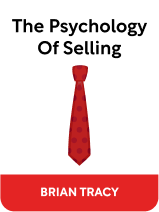

This article is an excerpt from the Shortform book guide to "The Psychology Of Selling" by Brian Tracy. Shortform has the world's best summaries and analyses of books you should be reading.
Like this article? Sign up for a free trial here .
Do you work in face-to-face sales? What do you think is the key to converting a sales prospect into a customer in a face-to-face sales meeting?
In high-profile business-to-business sales, customers often request a face-to-face sales meeting that explains how the product/service works and how it will contribute to their company’s success. The key to making your proposition stand out from competitors is to plan your meeting in advance: how to open it, how to pre-empt objections, how to close etc.
In this article, we’ll discuss techniques to make your sales presentation as effective as possible.
1. Know Your Buyer
To really nail your sales meetings, you’ll have to tailor it to each particular prospect you speak with. There are six common types of customers, with an approximate percentage of the buyers in each category.
- The Reluctant Customer: About 5 percent of customers are suspicious, cynical, and chronically uninterested. This type of buyer will generally focus on the aspect of a pitch that she finds negative and will never move off of that topic; she’s unlikely to ever say “yes” to a proposal, so don’t spend a lot of time with her. Extricate yourself as politely as you can, and look for someone else more open to your message.
- The Certain Customer: About 5 percent of your buyers will be the exact opposite of the reluctant buyer: They’ll know exactly what features and benefits they need and what price they’re prepared to pay. When meeting with a certain customer, sell her exactly what she’s looking for—if you try to oversell her when she’s not interested, she’s going to be put off, and you may lose the sale entirely. You can give her additional information, but expect her to know her limits and stick to them.
- The Analytical Customer: About 25 percent of your buyers will fall into this category. These buyers move slowly to be sure they make the right decision. They love details and want you to prove everything you claim on paper. Don’t rush this buyer. Be methodical, go over details thoroughly, and take time to fully answer each question.
- The Relationship Customer: Another 25 percent of your buyers will prioritize being liked and getting along with people. This type of buyer wants to build a relationship with you before committing to a purchase. She needs time to make a decision and values the opinions of others highly when evaluating products or services. When dealing with a relationship customer, slow down and ask a lot of questions. Talk about other customers who have been happy with your products or services. You may need more than one meeting to close the sale.
- The Directive Customer: Another 25 percent of your buyers will be directive customers, who are task-oriented. This buyer is busy, businesslike, and practical. She is laser-focused on the benefits your product can provide and doesn’t care about building a warm relationship with you personally. When dealing with a directive customer, don’t bother with small talk, and don’t go into details on background information, like how your product was developed. Focus on the bottom line: exactly how your product can help her. Get right to the point so she doesn’t feel you’re wasting her time.
- The Social Customer: About 25 percent of your customers will be social customers, who are gregarious and extroverted. You’ll often find this type of buyer in fields that involve a high degree of integration between teams of people—supervisors, project managers, orchestra conductors, and senior executives of large firms. When dealing with a social buyer, expect her to be talkative and friendly, and be positive and open in return. If she agrees to a purchase, be sure to get it in writing immediately—this type of buyer is prone to forgetting commitments soon after she makes them.
2. Open Strongly
No matter which type of customer you’re dealing with, you need to have a strong opening to your presentation. An ideal opening will plant the seeds for a strong closing, giving you a much higher percentage of successful sales. We’ll look at two techniques in particular.
- The “fair exchange” opening
- The “qualifier” opening
Each of these gets your customer to agree to give you an answer at the end of your presentation, preventing her from putting you off with a vague “I’ll have to think about it.”
The Fair Exchange Opening
With this opening, you propose a fair exchange: “The only thing I’d like to do today is show you why so many others in your industry have purchased this product and rave about it. All I ask is that you take a look at what I’m going to show you, think it over with an open mind, and at the end of our conversation, let me know if you think it applies to your situation. Does that sound fair?”
This technique does two things: First, it hints that other people have high opinions of your product, which appeals to the prospect’s desire for social approval that we discussed earlier.
Second, it allows you to remind your prospect at the end of the presentation that she agreed to give you an answer. If she says, “I have to think about it,” you can say, “I appreciate that, but you did promise to tell me if my product would or wouldn’t help your situation.”
The Qualifier Opening
With the qualifier opening, you begin the meeting with a question that both emphasizes the primary benefit of your product and also qualifies your prospect, or evaluates whether or not she’s able to make a purchase. For example, “If I show you the smartest investment on the market, are you able to invest $10,000?” If your prospect replies that she is not able to invest that much right now, you can follow up with a lower number: “Would you be able to invest $6,000?”
This question changes the focus from, “Let me show you something” to “Are you capable of reaping these benefits?” It makes her try to qualify herself, and it gives you the ability to force your prospect to make a decision at the end of your meeting. She can’t say she has to discuss your proposal with someone else because she’s already admitted she can commit.
3. Show, Tell, Ask
Another technique to keep your prospect engaged is the show-tell-ask structure. This is a simple but effective format for a presentation. Essentially, you show the prospect a feature, tell her how she would benefit, and ask follow-up questions.
Show
Within the “show” piece of this structure, be sure to introduce features one at a time. This is the difference between top salespeople and bottom salespeople: Top salespeople will go through features one at a time and make sure that the customer understands each one and has a chance to ask questions along the way. Mediocre salespeople will excitedly run through a string of features and will end up overwhelming their prospect. When this happens, a prospect has no choice but to say, “I’ll have to think it over,” which means you’ve lost the deal.
Tell
Within the “tell” piece of this structure, you can use this additional three-part structure: “Because of (feature)… You can (benefit)… Which means (relevance)…” With this structure, you link the product feature to its benefit, and then make it relevant to the customer. For example, if you were selling a flat-screen television, you might say, “Because of the pixel technology (feature), you can view the screen from any angle (benefit), which means when you have a party, everyone can enjoy the game (relevance).
Ask
Within the “ask” piece of this structure, use logic to press your case. While customers make decisions emotionally, as we’ve previously discussed, they also like to feel their rational needs are being addressed. Ask a series of questions that build upon one another to lead your prospect to the logical conclusion that buying your product is the right choice. For example, if you’re selling sales training programs, you might ask:
- “Are your most motivated salespeople the highest-performing ones or the lowest-performing ones?”
- “Wouldn’t you agree that people are most motivated when they feel competent and confident they can get the results they want?”
4. Have a Conversation With Your Customer
During your meeting, you’ll need to engage in a conversation that allows your customer to open up and tell you what she’s looking for. In doing so, you’ll need to:
- Position yourself as trustworthy.
- Ask questions.
- Emphasize your product or service’s key benefits.
Position Yourself as Trustworthy
To encourage a conversation in which your customer feels comfortable discussing her needs and listening to your solutions, you’ll need to come across as trustworthy. The best way to seem trustworthy is to position yourself as a friend or advisor rather than a salesperson. Focus on helping her rather than selling your product. This makes her feel your meeting is about her, not you, and dramatically reduces the likelihood of rejection.
It’s also crucial that you come across as honest, or your customer will reject you immediately. Therefore, don’t oversell the benefits of your product, but instead explain simply and truthfully how your product or service can help her.
Ask Questions
To encourage an open conversation, ask questions. People love to talk about themselves, so let them. More often than not, if you let a customer talk, she’ll reveal to you what would convince her to make a sale. Asking questions has several advantages:
- Asking questions puts the spotlight on the customer, which is where it should be. Again, people like to be the center of attention, and keeping the focus of the conversation on your customer rather than on you or your products keeps her happy and makes her feel her needs are central. It increases the likelihood of a sale.
- Asking questions puts you in the driver’s seat. In general, in any dynamic between two people, the person who asks the questions is in control of the conversation, directing the topics and the flow, and the person responding is in the less dominant position. If your customer asks a question of you, you can regain control of the conversation by saying, “That’s a great question. Can I ask you something first?”
Emphasize Your Offering’s Key Benefits
When a customer buys a product or a service, she’s actually buying a benefit—a solution to a problem or a need—and not a specific item. She cares only about how your product will help her or her business. Accordingly, when opening a conversation with a potential customer, state your idea’s benefit up front. Anything else—a description of your product, or an endorsement of your service—makes your presentation about you, not her, and will put her off.
5. Close Effectively
It’s important to close as soon as your prospect is ready. Watch for this readiness as you go through your presentation. Often, a salesperson will actually delay—and sometimes lose—a sale because she doesn’t ask for it soon enough based on her customer’s cues.
Close With a Hot-Button Issue
Now that you’ve had an open conversation, you should have identified the hot-button issue: the issue that your customer cares about over every other issue. If your previous questions haven’t revealed the hot-button issue by this point, you can very often discover it by asking a hypothetical question along the lines of, “If you were going to buy this product now or at any time in the future, what would cause you to do so?” Making it hypothetical often inspires the customer to reveal what would convince her to move forward with the sale. Once you know her hot-button issue, continue to press it, over and over. Make the entire decision revolve around that issue.
Assume the Sale
As soon as you’ve identified your prospect’s hot-button issue and gotten her to agree that your product addresses it, assume she agrees to the sale and act accordingly. In other words, force your customer to stop the sale from going through rather than wait for her to ask for the sale to happen. For example, after she agrees that your product can help her double her sales, take out an order sheet and start filling it out. Often, a prospect will not stop you: They agree with your assessment and just need a little push to keep the momentum going.

———End of Preview———
Like what you just read? Read the rest of the world's best book summary and analysis of Brian Tracy's "The Psychology Of Selling" at Shortform .
Here's what you'll find in our full The Psychology Of Selling summary :
- How to dramatically increase your sales
- How to know what your customers are thinking
- Brian Tracy's 10 guidelines for success






